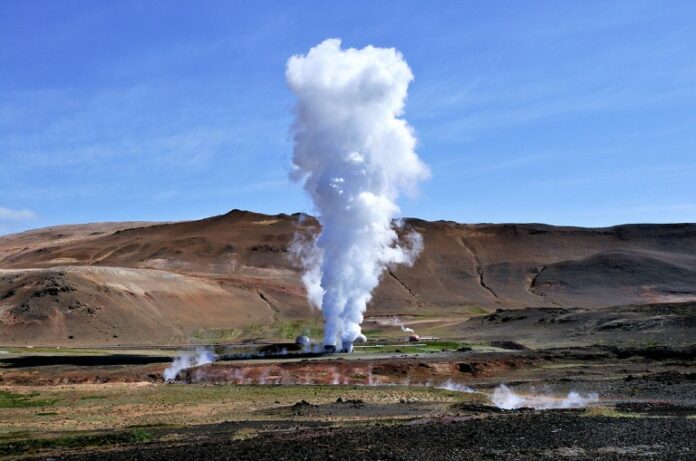Jane Marsh is an environmental journalist and the Editor-in-Chief of Environment.co. Her interests focus on environmental issues, sustainability and renewable energy. She has written for Renewable Energy Magazine, Manufacturing.net, and Nation of Change. This is her first contribution to 21st Century Tech Blog where she discusses how geothermal energy can play a significant role in the transition to all-electric transportation. When not writing, Jane is a hiker, canoeist and an enthusiast for all things nature.
Can geothermal energy help to increase the use of lithium battery technology? With so much emphasis on solar and wind power as less-expensive renewable power alternatives, geothermal energy is often overlooked as one of the world’s cleanest energy sources. But as the world ramps up its lithium oxide capacity to meet the growing demand for electric vehicles (EV), the technology may finally be getting its day in the sun.
Of course, many might wonder why the increasing desperation for lithium, and then again why geothermal energy sources could contribute to a lithium-based electric world. Well, the world is about to find out.
Desperate Times Call for More Lithium
Under the current U.S. administration, the country is investing $100 billion in domestic manufacturing for EVs with the target goal of 50% in new car sales by 2030. EVs, however, require lithium-ion batteries in the absence of other material alternatives that have yet to be commercially developed.
A current challenge to our lithium dependency for EVs is that China dominates global markets with 1.5 million tons of lithium reserves. China’s lithium-ion battery manufacturing capacity has reached 74%, whereas the U.S. is only at 8%. That shortfall has to be made up with experts believing the U.S. alone will need 2.2 million tons of lithium-ion batteries to reach its goal by 2030. Currently, the country is heavily dependent on lithium imports from Russia (that’s changing because of the Ukraine war), Chile, Argentina, and China.
Another source is the recovery and recycling of existing lithium in batteries that today end up in landfills. Yet, recovery process improvements are needed, to ensure a domestic supply from these sources which can then supplement new lithium mines.
Environmental Impact of Lithium Extraction
Lithium mining poses significant environmental risks. A single ton yield requires 2.2 million litres of water. Its extraction degrades soil and drinking water reserves, and emits toxic air pollutants causing nearby communities to be put at risk.
The Atacama Desert in Chile is a principle lithium source. There conflicts have erupted with local communities in the last four years because of a 65% decline in water resources caused by lithium mining operators.
Other studies show that the carbon dioxide (CO2) and sulphur-acid emissions associated with lithium mining account for 40% of lithium-ion battery production’s climate impact. The National Insitute of Environmental Health Sciences warns that lithium contributes to ozone and particulate matter pollution in the atmosphere leading to respiratory and cardiovascular disease, worsening allergies, asthma and reduced lung function.
These are the consequences of attempting to build an EV industry that advertises itself as 100% environmentally sustainable in support of achieving net zero emissions.
So where does geothermal energy enter the picture to alter the environmental and human risks of the EV transition?
Geothermal Can Lead to Sustainable Lithium Production
Geothermal energy is a renewable power source that derives from the earth’s internal heat. It is a nearly zero-emission source of continuous energy. Geothermal energy requires drilling into the Earth and in the process these facilities extract saline solutions containing lithium, zinc, and manganese.
In the Salton Sea in California, engineers today are extracting lithium salt from the hot liquids found at depths of 1,220 metres (4,000 feet). These results point to the potential of geothermal plants not only becoming a growing renewable energy source but also a primary means of lithium production contributing to 10% or more of current demand for EV batteries.
Currently, geothermal energy costs between $4,000 and $6,000 per kilowatt-hour making it more expensive than solar and wind renewable sources. But economies of scale would suggest that in time geothermal will become more cost competitive with these existing renewable sources that in their time were far more expensive than electricity produced from fossil fuel sources.
Another benefit of geothermal energy is its tiny footprint on the landscape. A typical geothermal field uses 0.4 to 3 hectares (1 to 8 acres) per Megawatt produced compared to 4 hectares (10 acres) for a solar array, 7.7 hectares (19 acres) for a coal-fired powerplant, and 8 to 16 hectares (20 to 40 acres) for wind turbines. And extracting lithium from a geothermal energy source would be far less destructive to the environment than current mining operations with less demand on land and freshwater resources, and fewer destructive emissions.
When you consider geothermal capacity currently in the U.S. at 3,676 Megawatts and a Department of Energy estimate of 530 Gigawatts in potential, one can see just how significant the rapid development of this renewable energy source can contribute not only to reducing greenhouse gas emissions but also to the production of environmentally sustainable lithium for EV batteries.










[…] is an environmental journalist and Editor-in-Chief of Environment.co. Last month she wrote about geothermal energy. Today she is tackling […]